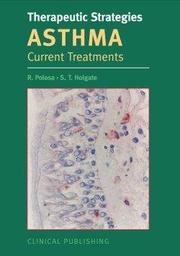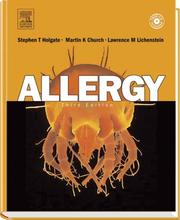| Listing 1 - 10 of 13 | << page >> |
Sort by
|

ISBN: 1281054216 9786611054212 0080526926 0123523354 Year: 1999 Publisher: San Diego, CA : Academic Press,
Abstract | Keywords | Export | Availability | Bookmark
 Loading...
Loading...Choose an application
- Reference Manager
- EndNote
- RefWorks (Direct export to RefWorks)
Concern about the impact of air pollution has led governments and local authorities across the world to regulate, among other things, the burning of fossil fuels, industrial effluence, cigarette smoke, and aerosols. This legislation has often followed dramatic findings about the impact of pollution on human health. At the same time there have been significant developments in our ability to detect and quantify pollutants and a proliferation of urban and rural air pollution networks to monitor levels of atmospheric contamination.Air Pollution and Health is the first fully comprehensiv
Air. --- Air--Pollution--Health aspects. --- Air --- Environmental Pollution --- Health Occupations --- Disciplines and Occupations --- Public Health --- Air Pollution --- Environmental Health --- Environment and Public Health --- Health Care --- Health & Biological Sciences --- Health aspects --- Pollution --- Health aspects. --- Pollution. --- Toxicology. --- Physiological effect. --- Air contaminants --- Air pollutants --- Air pollution --- Air pollution control --- Air toxics --- Airborne pollutants --- Atmosphere --- Contaminants, Air --- Control of air pollution --- Pollutants, Air --- Toxics, Air --- Control --- Air quality --- Atmospheric deposition --- Aspect sanitaire --- ELSEVIER-B EPUB-LIV-FT --- AIR POLLUTION --- ENVIRONMENTAL POLLUTION --- RESPIRATORY SYSTEM --- PUBLIC HEALTH --- BIOLOGICAL MARKERS --- ADVERSE EFFECTS --- ECONOMICS
Book
ISBN: 0702045705 0702050415 0723436584 1336272058 9780702050411 9780723436584 Year: 2012 Publisher: Edinburgh : Elsevier,
Abstract | Keywords | Export | Availability | Bookmark
 Loading...
Loading...Choose an application
- Reference Manager
- EndNote
- RefWorks (Direct export to RefWorks)
Annotation
Allergy. --- Allergic diseases --- Allergies --- Hypersensitivity --- Hypersensitivity, Immediate --- Immediate allergy --- Immediate hypersensitivity --- Immunologic diseases --- Immunoglobulin E --- Hypersensitivity. --- Allergie --- Allergy and Immunology --- Allergy Specialty --- Allergy, Immunology --- Immunology and Allergy --- Immunology, Allergy --- Immunology --- Specialty, Allergy
Book
ISBN: 1904392709 9786610751228 1280751223 1846925649 Year: 2007 Publisher: Oxford : Atlas Medical Publishing Ltd,
Abstract | Keywords | Export | Availability | Bookmark
 Loading...
Loading...Choose an application
- Reference Manager
- EndNote
- RefWorks (Direct export to RefWorks)
The care of an increasing number of adult and child patients with asthma has become a major task for clinicians, and a growing concern for public health physicians and health care administrators. At the same time, and in response to this situation, a considerable effort is being made in basic and clinical research to develop new treatments. This book looks into the future and assesses the possibilities of a number of new therapies for asthma under exploration and development. A group of distinguished international authors examine the potential of new agents working on various targets that are
Anti-inflammatory agents. --- Asthma -- Treatment. --- Asthma. --- Respiratory Hypersensitivity --- Lung Diseases, Obstructive --- Respiratory System Agents --- Bronchial Diseases --- Respiratory Tract Diseases --- Therapeutic Uses --- Lung Diseases --- Hypersensitivity, Immediate --- Diseases --- Hypersensitivity --- Pharmacologic Actions --- Chemical Actions and Uses --- Immune System Diseases --- Chemicals and Drugs --- Asthma --- Anti-Asthmatic Agents --- Asthma, Bronchial --- Bronchial Asthma --- Asthmas --- Diseases of Immune System --- Immune Diseases --- Immunological Diseases --- Immune Disorders --- Immunologic Diseases --- Disease, Immune --- Disease, Immune System --- Disease, Immunologic --- Disease, Immunological --- Diseases, Immune --- Diseases, Immune System --- Diseases, Immunologic --- Diseases, Immunological --- Disorder, Immune --- Disorders, Immune --- Immune Disease --- Immune Disorder --- Immune System Disease --- Immunologic Disease --- Immunological Disease --- Chemical Actions --- Actions, Chemical --- Actions, Pharmacologic --- Allergic Reaction --- Allergy --- Allergic Reactions --- Allergies --- Hypersensitivities --- Reaction, Allergic --- Reactions, Allergic --- Atopic Hypersensitivity --- Hypersensitivity, Atopic --- Hypersensitivity, Type I --- IgE-Mediated Hypersensitivity --- Type I Hypersensitivity --- Atopic Hypersensitivities --- Hypersensitivities, Atopic --- Hypersensitivities, IgE-Mediated --- Hypersensitivities, Immediate --- Hypersensitivities, Type I --- Hypersensitivity, IgE-Mediated --- IgE Mediated Hypersensitivity --- IgE-Mediated Hypersensitivities --- Immediate Hypersensitivities --- Immediate Hypersensitivity --- Type I Hypersensitivities --- Disease, Pulmonary --- Diseases, Pulmonary --- Pulmonary Disease --- Pulmonary Diseases --- Disease, Lung --- Diseases, Lung --- Lung Disease --- Obstructive Lung Diseases --- Obstructive Pulmonary Diseases --- Lung Disease, Obstructive --- Obstructive Lung Disease --- Obstructive Pulmonary Disease --- Pulmonary Disease, Obstructive --- Pulmonary Diseases, Obstructive --- Therapeutic Effects --- Effects, Therapeutic --- Uses, Therapeutic --- Disease, Respiratory Tract --- Diseases, Respiratory Tract --- Respiratory Tract Disease --- Tract Disease, Respiratory --- Tract Diseases, Respiratory --- Bronchial Disease --- Disease, Bronchial --- Diseases, Bronchial --- Respiratory Stimulants --- Agents, Respiratory System --- Stimulants, Respiratory --- Airway Hyper-Responsiveness --- Hypersensitivity, Respiratory --- Airway Hyper Responsiveness --- Hyper-Responsiveness, Airway --- Hypersensitivities, Respiratory --- Respiratory Hypersensitivities --- Anti-Asthmatic Drugs --- Anti-Asthmatics --- Antiasthmatic Agents --- Antiasthmatic Drugs --- Antiasthmatics --- Agents, Anti-Asthmatic --- Agents, Antiasthmatic --- Anti Asthmatic Agents --- Anti Asthmatic Drugs --- Anti Asthmatics --- Drugs, Anti-Asthmatic --- Drugs, Antiasthmatic --- Bronchial Hyperreactivity --- Pharmacological and Toxicological Phenomena --- Drug Therapy --- Antigen-Antibody Reactions --- Histamine --- Histamine H1 Antagonists --- Latex Hypersensitivity --- Immune System Disorders --- Disorder, Immune System --- Immune System Disorder --- Anti-Asthmatic --- Anti-Asthmatic Agent --- Anti-Asthmatic Drug --- Antiasthmatic --- Antiasthmatic Agent --- Antiasthmatic Drug --- Agent, Anti-Asthmatic --- Agent, Antiasthmatic --- Anti Asthmatic --- Anti Asthmatic Agent --- Anti Asthmatic Drug --- Drug, Anti-Asthmatic --- Drug, Antiasthmatic --- Therapeutic Effect --- Therapeutic Use --- Effect, Therapeutic --- Use, Therapeutic --- Respiratory Diseases --- Respiratory System Diseases --- Disease, Respiratory System --- Respiratory System Disease --- Airway Hyperresponsiveness --- Airway Hyperresponsivenesses --- Hyperresponsiveness, Airway --- Respiratory Hypersensitivity. --- Lung Diseases, Obstructive. --- Respiratory System Agents. --- Bronchial Diseases. --- Respiratory Tract Diseases. --- Therapeutic Uses. --- Lung Diseases. --- Hypersensitivity, Immediate. --- Disease. --- Hypersensitivity. --- Pharmacologic Actions. --- Chemical Actions and Uses. --- Immune System Diseases. --- Anti-Asthmatic Agents.
Book
ISBN: 128245322X 9786612453229 1905832737 1905832664 9781905832736 6612453222 9781905832668 Year: 2010 Publisher: Abingdon, Oxford : Health Press Ltd.,
Abstract | Keywords | Export | Availability | Bookmark
 Loading...
Loading...Choose an application
- Reference Manager
- EndNote
- RefWorks (Direct export to RefWorks)
Despite the availability of many effective treatments for asthma, patients' control of the condition is often suboptimal. Now in its third edition, Fast Facts: Asthma delivers a clear practical message - improved asthma control can be achieved through efficient commonsense delivery of asthma care.This highly readable and well-illustrated book examines the essentials of good asthma care, distilled from the latest international guidelines and best available evidence. These include:- accurate asthma diagnosis- identification of risk factors and triggers- objective assessment of airway inflammatio
Asthma. --- Bronchial asthma --- Bronchi --- Lungs --- Respiratory allergy --- Diseases --- Diseases, Obstructive

ISBN: 1846920159 9786610751266 1280751266 1846925789 Year: 2007 Publisher: Oxford : Atlas Medical Publishing Ltd,
Abstract | Keywords | Export | Availability | Bookmark
 Loading...
Loading...Choose an application
- Reference Manager
- EndNote
- RefWorks (Direct export to RefWorks)
As the incidence of asthma in the adult population continues to increase, and the age of onset in children to decrease, this condition remains a primary concern not only for specialists in respiratory medicine, but also for physicians in many other fields, when dealing with the asthmatic patient. The range of therapeutic agents now available, and the diversity of targets on which they act, presents the doctor with a variety of options for managing the condition. In this volume leading international authorities explain the mechanisms of action of the drugs currently in use, and their clinical a
Book
ISBN: 9780323544245 032354424X Year: 2020 Publisher: Amsterdam Elsevier
Abstract | Keywords | Export | Availability | Bookmark
 Loading...
Loading...Choose an application
- Reference Manager
- EndNote
- RefWorks (Direct export to RefWorks)
Through eight outstanding editions, Middleton’s Allergy: Principles and Practice has been the reference of choice for both clinicians and researchers as both a practical reference and an effective self-assessment tool for board preparation. The 9th Edition continues the tradition of excellence with comprehensive coverage of all basic science and clinical applications regarding allergy practice and disease mechanisms. It brings you fully up to date with recent innovations in the diagnosis, prevention, and management of allergic disorders, including emerging global issues, the advent of precision medicine, and new immunologic therapies.
Allergy --- Allergy and Immunology --- Allergic diseases --- Allergies --- Hypersensitivity --- Hypersensitivity, Immediate --- Immediate allergy --- Immediate hypersensitivity --- Immunologic diseases --- Immunoglobulin E --- Allergy Specialty --- Allergy, Immunology --- Immunology and Allergy --- Immunology, Allergy --- Immunology --- Specialty, Allergy --- Diagnosis

ISBN: 0323032273 9780323032278 9780323058087 0323058086 Year: 2006 Publisher: [Place of publication not identified] Mosby Elsevier
Abstract | Keywords | Export | Availability | Bookmark
 Loading...
Loading...Choose an application
- Reference Manager
- EndNote
- RefWorks (Direct export to RefWorks)
Hypersensitivity. --- Allergy. --- Allergie --- ALLERGY AND IMMUNOLOGY --- Hypersensitivity --- ALLERGY AND IMMUNOLOGY. --- Allergy and Immunology. --- Allergy --- Immune System Diseases --- Diseases --- Medicine --- Health & Biological Sciences --- Clinical Immunology --- Allergic Reaction --- Allergic Reactions --- Allergies --- Hypersensitivities --- Reaction, Allergic --- Reactions, Allergic --- Diseases of Immune System --- Immune Diseases --- Immunological Diseases --- Immune Disorders --- Immune System Disorders --- Immunologic Diseases --- Disease, Immune --- Disease, Immune System --- Disease, Immunologic --- Disease, Immunological --- Disorder, Immune System --- Immune Disease --- Immune Disorder --- Immune System Disease --- Immune System Disorder --- Immunologic Disease --- Immunological Disease --- Allergic diseases --- Hypersensitivity, Immediate --- Immediate allergy --- Immediate hypersensitivity --- Immunologic diseases --- Immunoglobulin E --- Immune System Diseases. --- Disease.
Book
ISBN: 4431998624 4431883169 9786612048135 1282048139 4431883177 Year: 2009 Publisher: Tokyo ; London : Springer,
Abstract | Keywords | Export | Availability | Bookmark
 Loading...
Loading...Choose an application
- Reference Manager
- EndNote
- RefWorks (Direct export to RefWorks)
When I entered the field of allergy in the early 1970s, the standard textbook was a few hundred pages, and the specialty was so compact that texts were often authored entirely by a single individual and were never larger than one volume. Compare this with Allergy Frontiers: Epigenetics, Allergens, and Risk Factors, the present s- volume text with well over 150 contributors from throughout the world. This book captures the explosive growth of our specialty since the single-author textbooks referred to above. The unprecedented format of this work lies in its meticulous attention to detail yet comprehensive scope. For example, great detail is seen in manuscripts dealing with topics such as “Exosomes, naturally occurring minimal antigen presenting units” and “Neuropeptide S receptor 1 (NPSR1), an asthma susceptibility gene.” The scope is exemplified by the unique approach to disease entities normally dealt with in a single chapter in most texts. For example, anaphylaxis, a topic usually confined to one chapter in most textbooks, is given five chapters in Allergy Frontiers. This approach allows the text to employ multiple contributors for a single topic, giving the reader the advantage of being introduced to more than one vi- point regarding a single disease.
Allergy -- Epidemiology. --- Allergy -- Immunological aspects. --- Allergy -- Immunotherapy. --- Allergy. --- Medicine --- Health & Biological Sciences --- Clinical Immunology --- Allergy --- Epidemiology. --- Immunological aspects. --- Immunotherapy. --- Allergic diseases --- Allergies --- Hypersensitivity --- Hypersensitivity, Immediate --- Immediate allergy --- Immediate hypersensitivity --- Medicine. --- Immunology. --- Internal medicine. --- Medicine & Public Health. --- Allergology. --- Internal Medicine. --- Immunologic diseases --- Immunoglobulin E --- Medicine, Internal --- Immunobiology --- Life sciences --- Serology
Book
ISBN: 4431540768 4431993614 9786612828089 4431993622 1282828088 Year: 2010 Publisher: Tokyo : Springer-Verlag,
Abstract | Keywords | Export | Availability | Bookmark
 Loading...
Loading...Choose an application
- Reference Manager
- EndNote
- RefWorks (Direct export to RefWorks)
When I entered the field of allergy in the early 1970s, the standard textbook was a few hundred pages, and the specialty was so compact that texts were often authored entirely by a single individual and were never larger than one volume. Compare this with Allergy Frontiers: Epigenetics, Allergens, and Risk Factors, the present s- volume text with well over 150 contributors from throughout the world. This book captures the explosive growth of our specialty since the single-author textbooks referred to above. The unprecedented format of this work lies in its meticulous attention to detail yet comprehensive scope. For example, great detail is seen in manuscripts dealing with topics such as “Exosomes, naturally occurring minimal antigen presenting units” and “Neuropeptide S receptor 1 (NPSR1), an asthma susceptibility gene.” The scope is exemplified by the unique approach to disease entities normally dealt with in a single chapter in most texts. For example, anaphylaxis, a topic usually confined to one chapter in most textbooks, is given five chapters in Allergy Frontiers. This approach allows the text to employ multiple contributors for a single topic, giving the reader the advantage of being introduced to more than one vi- point regarding a single disease.
Allergy -- Epidemiology. --- Allergy -- Immunological aspects. --- Allergy -- Immunotherapy. --- Allergy. --- Medicine --- Clinical Immunology --- Health & Biological Sciences --- Allergy --- Prevention. --- Treatment. --- Allergic diseases --- Allergies --- Hypersensitivity --- Hypersensitivity, Immediate --- Immediate allergy --- Immediate hypersensitivity --- Medicine. --- Immunology. --- Internal medicine. --- Medicine & Public Health. --- Allergology. --- Internal Medicine. --- Immunologic diseases --- Immunoglobulin E --- Medicine, Internal --- Immunobiology --- Life sciences --- Serology
Book
ISBN: 4431998616 4431883142 9786612048128 1282048120 4431883150 Year: 2009 Publisher: Tokyo ; New York : Springer,
Abstract | Keywords | Export | Availability | Bookmark
 Loading...
Loading...Choose an application
- Reference Manager
- EndNote
- RefWorks (Direct export to RefWorks)
When I entered the field of allergy in the early 1970s, the standard textbook was a few hundred pages, and the specialty was so compact that texts were often authored entirely by a single individual and were never larger than one volume. Compare this with Allergy Frontiers: Epigenetics, Allergens, and Risk Factors, the present s- volume text with well over 150 contributors from throughout the world. This book captures the explosive growth of our specialty since the single-author textbooks referred to above. The unprecedented format of this work lies in its meticulous attention to detail yet comprehensive scope. For example, great detail is seen in manuscripts dealing with topics such as “Exosomes, naturally occurring minimal antigen presenting units” and “Neuropeptide S receptor 1 (NPSR1), an asthma susceptibility gene.” The scope is exemplified by the unique approach to disease entities normally dealt with in a single chapter in most texts. For example, anaphylaxis, a topic u- ally confined to one chapter in most textbooks, is given five chapters in Allergy Frontiers. This approach allows the text to employ multiple contributors for a single topic, giving the reader the advantage of being introduced to more than one vi- point regarding a single disease.
Allergy -- Epidemiology. --- Allergy -- Immunological aspects. --- Allergy -- Immunotherapy. --- Allergy. --- Medicine --- Health & Biological Sciences --- Clinical Immunology --- Allergy --- Immunopathology. --- Allergic diseases --- Allergies --- Hypersensitivity --- Hypersensitivity, Immediate --- Immediate allergy --- Immediate hypersensitivity --- Medicine. --- Internal medicine. --- Medicine & Public Health. --- Allergology. --- Internal Medicine. --- Immunologic diseases --- Immunoglobulin E --- Medicine, Internal
| Listing 1 - 10 of 13 | << page >> |
Sort by
|

 Search
Search Feedback
Feedback About UniCat
About UniCat  Help
Help News
News